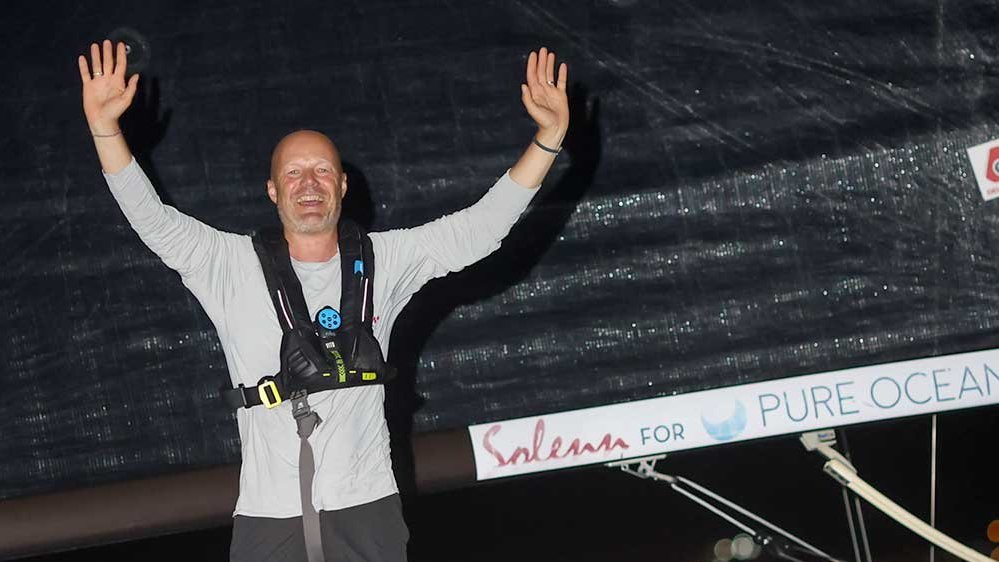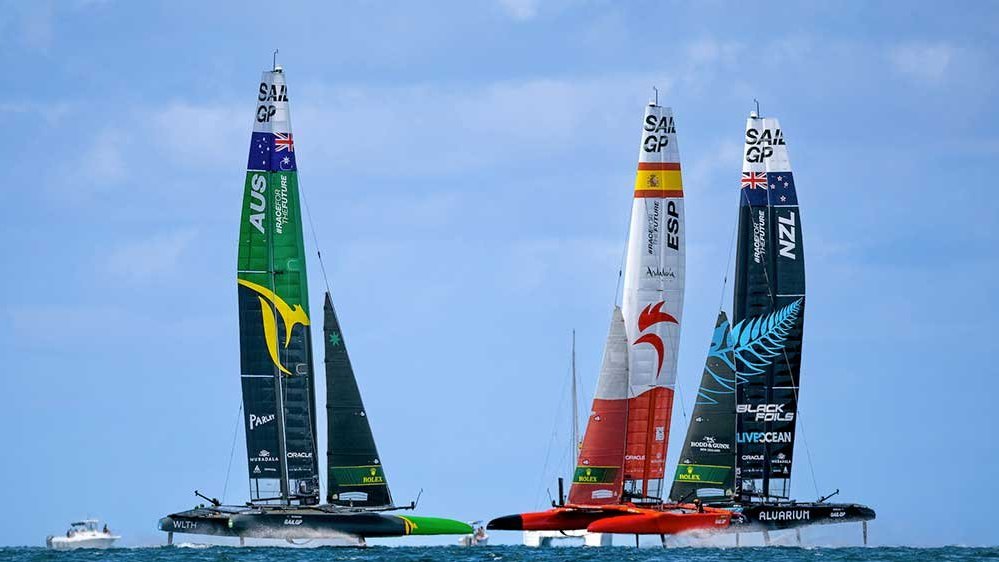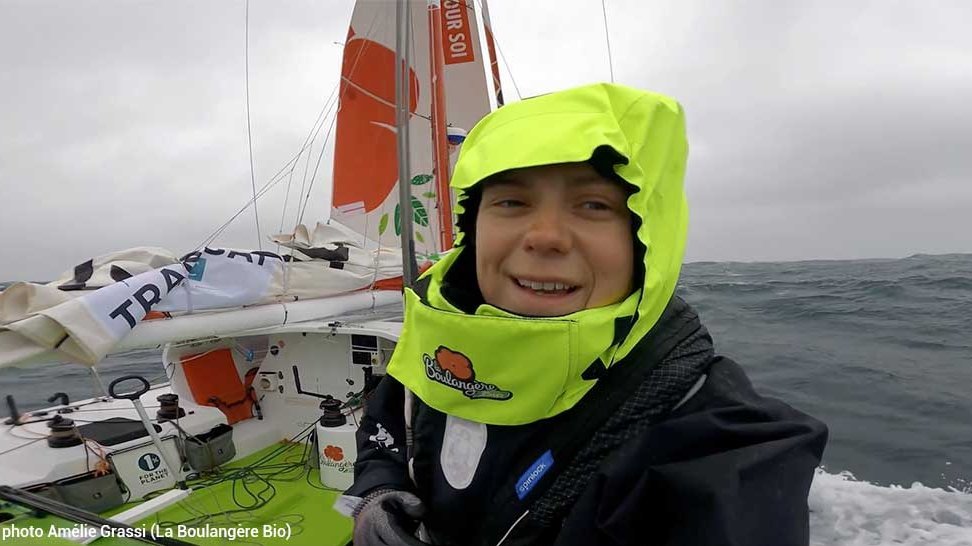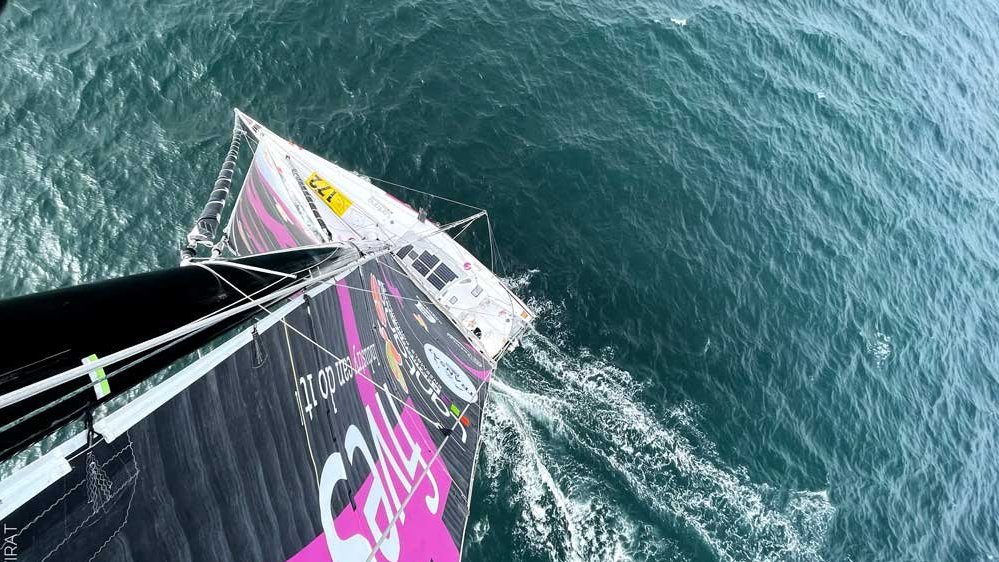Prize
Richard Wilson receives Cruising Club of America’s Blue Water medal
For his three voyages Wilson made between 1993 and 2003 in his 53’ trimaran Great American II
jeudi 20 janvier 2005 –
 The Blue Water Medal was inaugurated by the Cruising Club of America in 1923 to "reward meritorious seamanship and adventure upon the sea displayed by amateur sailors of all nationalities, that might otherwise go unrecognized." Blue Water Medallists have included such luminaries of the cruising sailing world as Rod Stephens, Eric and Susan Hiscock, Sir Francis Chichester, Eric Tabarly, Pete Goss and Bernard Moitessier.
The Blue Water Medal was inaugurated by the Cruising Club of America in 1923 to "reward meritorious seamanship and adventure upon the sea displayed by amateur sailors of all nationalities, that might otherwise go unrecognized." Blue Water Medallists have included such luminaries of the cruising sailing world as Rod Stephens, Eric and Susan Hiscock, Sir Francis Chichester, Eric Tabarly, Pete Goss and Bernard Moitessier.
"I love being at sea," said Wilson. "It stretches you to new limits, both intellectually, emotionally, and physically. You see glorious sights : whales, flying fish, the Aurora Australis, and soaring albatross. It is a perfect teaching vehicle - you hook the kids with the excitement of the adventure, and then you can teach them science, math, geography, history, decision-making, perseverance, and teamwork. Teaching kids from far at sea has been the best and highest use of me as a resource. And to have the CCA recognize my efforts is an ultimate honor, because CCA’s members have sailed so many, many blue water miles, and they know and love the sea."
Part I : A Challenging Beginning
In 1990, Wilson envisioned three clipper route challenges with the objective of equaling or beating record Record #sailingrecord passages. From the outset, the primary purpose of the voyages was to marry Wilson’s educational background with his passion for sailing to produce live, interactive "Ocean Challenge" school programs for grades K-12.
The first voyage, on the 15,000 mile California Gold Rush route from San Francisco to Boston, to beat the 76 day, 6 hour record Record #sailingrecord set by Northern Light in 1853, was started in the 60’ trimaran Great American with crew Steve Pettengill (Newport, R.I.). Wilson and Pettengill were making excellent progress until they encountered a severe storm and capsized, then righted, in a Force 12 storm with 65’ seas. In a dramatic midnight rescue, they were picked up 400 miles west of Cape Horn by the container ship New Zealand Pacific, alerted to their plight by satellite.
Starting again in 1993 with a new 53’ trimaran, Great American II, Wilson and his crew, Bill Biewenga (Newport, R.I.), left San Francisco only to run into dangerous 55-knot headwinds and steep 20-foot seas the first night, which broke off the bow of the port pontoon. Returning to port, the team built a new bow in nine days, and re-departed. By the time the two had reached the equator they had built a one-day lead over their "competitor," and they headed past Easter and Pitcairn Islands toward Cape Horn, which they passed after 32 days. Off the coast of Uruguay, they received a terrible battering and lost most of their communication Communication #Communication equipment. By the equator, they had built a three-day lead on Northern Light’s run and increased the lead to six days on their final run to Boston.
A year-long effort prior to the voyage to contract with Newspaper in Education programs and Prodigy, the largest U.S. online service, resulted in the publishing of a 14-part series in 12 major market newspapers, reaching 13 million readers weekly, 2500 teachers, and 250,000 schoolchildren, and the online participation of 200,000 people in Great American II’s Ocean Challenges adventure. Due to his own severe asthma, Wilson also had formed a promotional partnership with the American Lung Association (ALA) to connect to kids with asthma.
Part II : The Adventure Continues
Eight years later Wilson and Biewenga took on the second challenge, to beat the 69 day, 14 hour passage of the clipper Mandarin, from New York to Melbourne on the Australian Gold Rush route via the Cape of Good Hope and the Southern Ocean, set in 1855. They arrived in New York on the night of September 10, 2001. The next morning the World Trade Center was attacked. The trip was on hold for the next week while Wilson and Biewenga volunteered at a field hospital set up at Chelsea Piers where Great American II was berthed. On September 19, with special dispensation from the Coast Guard, which had closed the Port of New York, they set out for Melbourne and began their daily program with schoolchildren.
Unusual headwinds put them behind Mandarin in the first week. Struggling mightily across the equator and down the coast of Brazil, they slowly drew even. In the Indian Ocean they held a course in the "Roaring Forties" in company with albatrosses during the day and the Aurora Australis at night, all the while sailing in Antarctic-like cold. By Cape Leeuwin, Australia, their lead had dwindled to less than a day. In the last 1500 miles they hung on to their slim margin and entered Melbourne via The Cut to nip the record for the 15,400-mile voyage by 28 hours.
This Ocean Challenge school program was syndicated by Universal Press Syndicate, the premier newspaper syndication group in the U.S. And online, the program’s own sitesALIVE ! website featured daily logs, audio reports, question-and-answer sessions, essays, journals, photos and video clips from Great American II at sea. Additional promotional partnerships AOL@SCHOOL, ALA and the Asthma & Allergy Foundation of America (AAFA), extended the voyage reach to those constituencies.
Part III : The Final Chapter
The final challenge was to beat the passage record of 74 days, 14 hours for the Hong Kong to New York run on the China Tea Trade route set by the great clipper Sea Witch, in 1849. Great American II was sailed 5,400 miles from Australia to Hong Kong to be in position to begin the 15,200 mile challenge voyage. In March of 2003, Wilson and his new crewmate Rich du Moulin (Larchmont, N.Y.) were underway with a ceremonial packet of fine china tea aboard as cargo. Once clear of the crowded shipping lanes near Hong Kong, they sailed down the South China Sea, then entered the Indian Ocean via Sunda Strait and headed westward for the Cape of Good Hope. As they started up the Atlantic they had lost and regained the lead over Sea Witch seven times. Only by pressing the boat to the limit in the final 3500 mile sprint to the finish were they able to nip Sea Witch’s time by one day, 17 hours.
En route, Wilson and du Moulin spent five hours daily writing, photographing and transmitting the content of the Ocean Challenge school program. Seven major market newspapers carried an 11-part weekly series to nine million readers, 2500 teachers, and 250,000 schoolchildren. AOL@SCHOOL, ALA, and AAFA again joined as promotional partners.
Each of Great American II’s passages was recognized as a world record by either the Guinness Book of World Records or the World Speed Sailing Record Council.
Info Media Pro International
Voir en ligne : For more information on the CCA, visit http://www.cruisingclub.org
About the CCA
The Cruising Club of America is dedicated to offshore cruising and "the adventurous use of the sea" through efforts to improve seamanship, the design of seaworthy yachts, safe yachting procedures and environmental awareness. Now in its 83rd year, the club has ten stations throughout the U.S., Canada and Bermuda, with approximately 1200 members who are qualified by their experience in offshore passage making. In even numbered years, the CCA organizes the Newport to Bermuda Race in conjunction with the Royal Bermuda Yacht Club. It also sponsors several Safety at Sea seminars and hosts a series of "Suddenly Alone" seminars for the cruising couple.
Dans la même rubrique
Rolex Sydney Hobart Yacht Race 60th Anniversary : Aera historic British boat to win Sydney - Hobart handicap trophy
Petit Bateau 2004 : Michel Kleinjans Roaring Forty Wins the ANA Cup 1st Overall PB2004
Petit Bateau : 18 Entries for the Petit Bateau 2004 Singlehanded Race
Petit Bateau 2004 : Falmouth - Kinsale - Gijon - Camaret for 30’-50’ in July
 Sea, Sail & Surf news
Sea, Sail & Surf news










